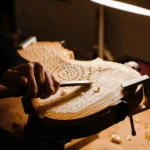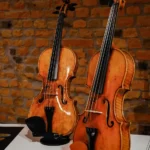What Every Violinist Wants For Christmas: Our Top Tips For You And Your Violin
Back to BlogWe all want to keep our violins in the best condition possible, after all, they are our musical partners! So, as a Christmas gift for you violinists and violins lovers, we want to share our top tips and tricks for you and your violin with you guys.
The first violin tip you’ll want to be aware of: the weather
It doesn’t seem that important, but the place where you live has an impact on your instrument. Different levels of humidity and temperatures affect your instrument and can cause damage without proper care. For that reason, we recommend you to check the relative humidity level in places where your instrument is most often kept.
As humidity levels change through the year with the seasons, it is essential to understand the impact this could be having on your instrument.
- It can cause changes to the instrument’s dimensions.
- A very dry atmosphere can cause the seams to open and cracks to appear in an instrument. (A relative humidity of less than 30%).
- In a very dry environment, the sound produced can become strident and harsh. In contrast, a humid climate makes the instrument’s sound lose power so that it sounds much sandier and more crackly.
- And dry weather can cause buzzing.
But how can you prevent all that?
- If the levels are too high, you can leave the violin in the sunlight for a few minutes BUT make sure you will not expose the violin during the hottest hours of the day and let it out for a maximum of 30 minutes.
- And if it’s too dry, you can moisten the instrument internally with a specific string instrument humidifier, such as Dampit.
REMEMBER to keep relative humidity levels at 50-60%, in the room your violin is stored, as well as the case!
The violin tip you can’t get tired of: Regular Cleaning
- After every practice, clean your violin with a dry flannel. This prevents the rosin from bonding with the varnish and sweeps sweat that can sometimes be released while playing.
- And don’t forget the strings! With use, the strings oxidize with the sweat of the hands that penetrates internally. You can clean the sweat by rubbing the string with a dry cloth until they warm up.
Take good care of your instrument’s accessories & fittings
Starting with the pegs. Over time, they become oval and adhere to only some parts of their orifice, while the ideal position is to embrace it fully. Our tip is: Wrap the strings around the peg and leave it leaning against the pegbox cheek.
This makes the pegs not jump out when the weather is dry and makes the instrument’s tuning much easier.
- And keep them well lubricated with graphite.
- Another fitting to always keep an eye on is the bridge. Make sure it’s always at a 90-degree angle. When adjusting it, loosen a bit of the strings to facilitate the movement. Do it carefully and gently; after all, we all know stringed instruments are delicate.
The soundpost on your stringed instrument should always be straight! To check this you will:
- Put your instrument in the horizontal position. Once horizontal, the soundpost should be like a column – straight and perpendicular to the top plate. You can use a flashlight to help you check it more thoroughly.
- If you think the soundpost is not in the right place, we wouldn’t advise you to adjust its position on your own. Please schedule a visit with a luthier if you think something might be wrong.
Other very important tips to know are:
- Fine tuners work well if you lubricate them, you can use graphite to facilitate the movement.
- Use a tissue with a few droplets of mineral oil and pass all over the chin rest to protect it from sweat.
- In order to keep the endpin screw-in optimal conditions, you can also lubricate it with graphite.
- Rosin should only be used when deemed completely necessary. Too much rosin can affect the sound quality of your instrument, and exaggerated amounts can make the sound dirty.
- Clean the bow hair by using a dry flannel. No products, no water!
- Clean the button’s screw every now and then. You can disassemble the bow, remove the frog from its position and wipe the moisture inside the frog channel with a cloth or tissue, especially if you sweat a lot; the sweat penetrates there and can create fungus; making it difficult for the frog to slide when you tension the bow.
- Last but not least, visit a luthier! Take it to a violin maker or luthier to keep it in perfect condition and for it to be appropriately cleaned and maintained.









